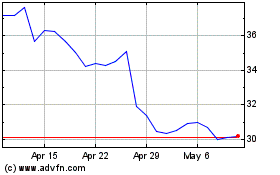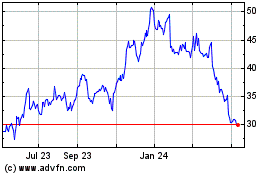Intel Buys Virtual-Reality Specialist Voke
November 03 2016 - 1:40PM
Dow Jones News
Intel Corp., continuing its push beyond chips for personal
computers, is buying a small company called Voke that developed
technology for creating virtual-reality experiences based on live
action.
Financial terms weren't disclosed. Voke, based in Intel's
hometown of Santa Clara, Calif., has about 20 employees, Intel
said.
Most virtual-reality software is based on animated scenes. But
Voke developed a system called TrueVR that uses sets of paired
cameras and software that help capture live images and simulate the
sensation of three-dimensional space for viewers with computer
displays or virtual-reality headsets.
The company, founded in 2004, works with broadcasters and others
to capture and stream action during events such as basketball games
and fashion shows to let users view the action from multiple
angles.
Sports has become a particular focus in the past year for Intel,
whose chip business has experienced the effects of a shrinking PC
market and the company's failure to gain traction in chips for
smartphones. Intel in March announced a deal to buy Replay
Technologies, an Israeli company whose 3-D video technology has
been used by some U.S. sports broadcasters. Terms weren't
disclosed, but The Wall Street Journal reported that the company
was expected to pay between $150 million and $170 million.
The chip maker, which has been marketing 3-D camera technology
known as RealSense, has also pushed into immersive headset
displays. Intel in August showed off Project Alloy, a prototype for
a headset with front-facing cameras to offer what Chief Executive
Brian Krzanich calls "merged reality"—a blend of animation and
real-world images supplied by the RealSense cameras.
Wendell Brooks, an Intel senior vice president and president of
its venture-capital unit, said virtual reality is an attractive
field because it requires computing horsepower that tends to drive
demand for Intel chips. Sports and gaming, meanwhile, are two areas
that drive considerable consumer spending and advertising dollars,
he said.
At the same time, the availability of new virtual-reality
headsets has outstripped high-quality programming for the hardware.
"There is not a lot of great content," Mr. Brooks said.
With the aid of Voke, he said, Intel can help address that
gap—particularly in the field of sports. "Voke is going to allow us
to accelerate our route to market with leagues and broadcasters,"
Mr. Brooks said.
Write to Don Clark at don.clark@wsj.com
(END) Dow Jones Newswires
November 03, 2016 13:25 ET (17:25 GMT)
Copyright (c) 2016 Dow Jones & Company, Inc.
Intel (NASDAQ:INTC)
Historical Stock Chart
From Mar 2024 to Apr 2024

Intel (NASDAQ:INTC)
Historical Stock Chart
From Apr 2023 to Apr 2024
